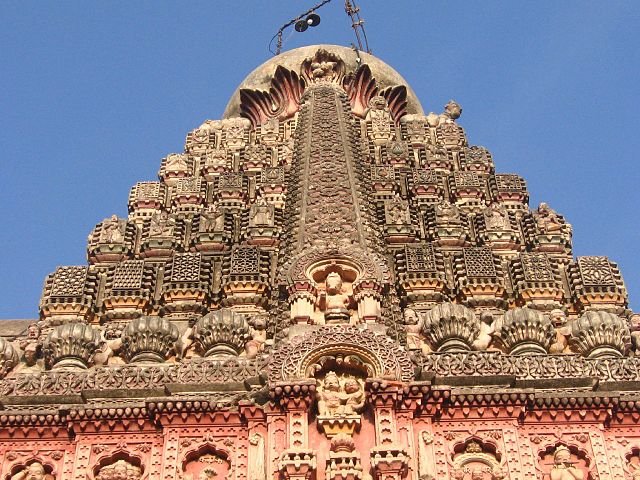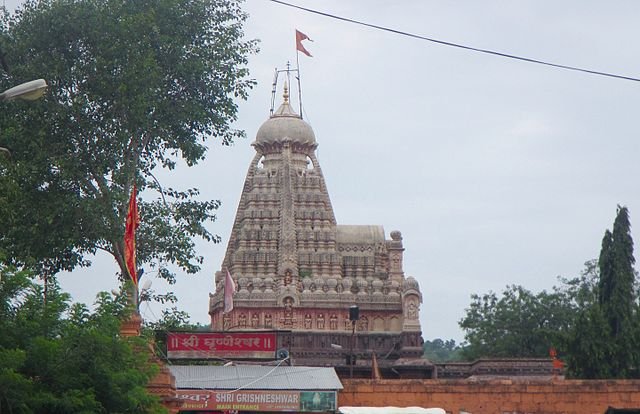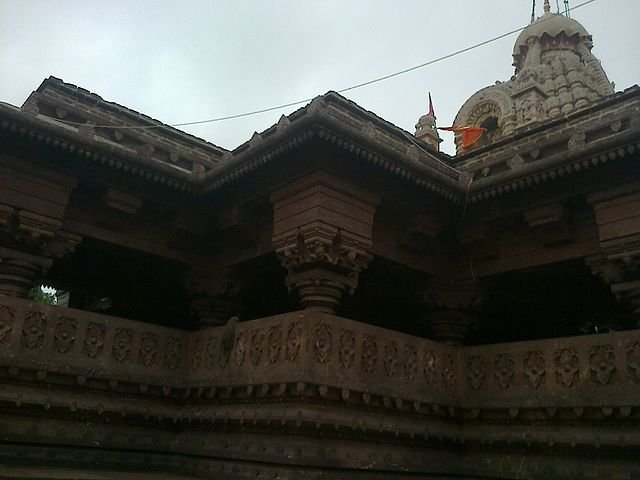Ghrishneshwar Temple is one of the most sacred and ancient Hindu temples in India Located in Verul village near Aurangabad, Maharashtra, this temple is dedicated to Lord Shiva and is one of the twelve Jyotirlingas. Manifesting the light of Lord Shiva, this temple is also known as Ghrishneshwar Mandir, Kusmeshwar Mandir and Ghrishneshwar Mandir. The temple has a rich and fascinating history of many cultivators and dynasties and is of immense spiritual significance to devotees who believe that a visit to the temple can bring them salvation and blessings.
In this blog we will elaborate on the history and spirituality of Ghrishneshwar Temple and learn more about how it is a must visit destination for anyone interested in Hindu culture and heritage. One day Pune to Aurangabad Tour Package by Private cab
Table of Contents
History of Grishneshwar Temple

The history of Grishneshwar Temple is a blend of mythology and historical facts. According to one legend, there was a devout woman named Ghushma who used to worship Lord Shiva by making and immersing lingas (symbolic representations of Shiva) in a nearby lake. She was blessed with a son, but her sister-in-law Sudeha was jealous of her and killed her son. Ghushma, however, continued her worship without losing faith in Shiva. Pleased with her devotion, Shiva resurrected her son and appeared as a jyotirlinga at the site of her worship.
According to another legend, there was a treasure hidden inside an anthill near the lake. A local chief named Maloji Bhosale discovered it and built a temple in honor of Shiva in the 16th century. He named it Grishneshwar, meaning “lord of compassion”. Maloji Bhosale was the grandfather of Chhatrapati Shivaji Maharaj, the founder of the Maratha Empire.
The temple was destroyed and rebuilt several times during the wars between the Mughals and the Marathas. The current structure was renovated by Queen Ahilyabai Holkar of Indore in the 18th century. She was a pious ruler who also restored many other Hindu temples across India.
The temple played an important role in the spread of Hinduism in the region. It attracted many pilgrims and saints who came to seek the blessings of Shiva. It also became a center of learning and culture, where various forms of art and literature flourished.
The temple has undergone several restoration works in recent times to preserve its ancient glory and heritage. It is now one of the most visited and revered temples in India
Architecture and Design of Grishneshwar Temple

Ghrishneshwar Temple is an excellent example of Maratha temple architecture and design. The temple is built of red sandstone which gives it a distinctive character and easily reflects the surrounding landscape well. The temple has at least five peaks that rise above the sanctum sanctorum. The peak is decorated with various legends and mythological stories of Lord Vishnu’s Dasavatar and floral motifs. The summit also has a vertical band called a ratha which is characteristic of a Maratha temple.
The temple has a large courtyard and a high wall around it. The temple has three entrances one main entrance and two side entrances. At the main entrance is a small shrine of Kokila Mata, the mother of Maloji Bhosale, who built the temple in the 16th century. At the side entrance are idols of Nandi and Lord Shiva’s bull mount. The temple has two chambers, a spacious sabha mandapam and the garbhagriha sabha mandapa with beautifully carved columns supporting the roof.
The courtyard of the auditorium is decorated with sculptures of various birds, animals, plants, hunters, musicians, dancers and girls playing in a circle.The assembly mandap is exposed on three sides with a lower wall and pillars on it. Among the Garbha planets is Lord Shiva’s black stone linga which is fixed in the subterranean orbit. The linga faces east and is worshiped as Ghrishneswara Meaning Lord of Karuna, Linga is one of the twelve Jyotirlingas, the manifestation of Shiva’s light.
It is worshiped by Hindus Garbha Graha measures 17 feet by seventeen feet and has a simple design. The Ghrishneshwar Temple is a unique and magnificent structure that reflects the artistic and religious sensibilities of the Maratha culture. This temple testifies to the devotion and resilience of the two who rebuilt it several times after it was destroyed by invaders. This temple is comparable to other famous temples in India such as Kashi Vishwanath Temple in Varanasi, Somnath Temple in Gujarat and Brihadishwar Temple in Tamil Nadu. There are Jyotirlinga temples which were restored by Rani Ahilyabai Holkar in the eighteenth year.
How to Rich Grishneshwar Temple

Visit Grishneshwar Temple By Road
Grishneshwar Temple is well connected by road with major cities of Maharashtra, such as Aurangabad, Pune, Nashik, Mumbai, etc. One can take a personal car or hire a private taxi or bus to reach the temple. The distance and approximate time taken by road from some of the nearby cities are:
- From Aurangabad: 30 km / 45 minutes
- From Pune: 256 km / 4.5 hours
- From Nashik: 187 km / 3 hours
- From Mumbai: 350 km / 6 hours
Visit Grishneshwar Temple By Train
The nearest railway station to Grishneshwar Temple is Aurangabad, which is about 22 km away from the temple. Aurangabad is connected by rail with Delhi, Mumbai, Hyderabad, Bhopal, Gwalior, etc. One can take a local transport such as auto rickshaw or bus from the railway station to the temple. Another major railway station near Grishneshwar Temple is Manmad, which is about 86 km away from the temple. Manmad is connected by rail with Ahmedabad, Bangalore, Chennai, Kolkata, etc. One can take a taxi or bus from Manmad to reach the temple.
Visit Grishneshwar Temple By Air
The nearest airport to Grishneshwar Temple is Aurangabad Airport, which is about 29 km away from the temple. Aurangabad Airport has regular flights from Delhi, Mumbai, Jaipur, Udaipur, etc. One can take a taxi or bus from the airport to reach the temple. Another option is to fly to Mumbai Airport or Pune Airport and then take a road or rail transport to reach the temple. Mumbai Airport and Pune Airport have domestic and international flights from various destinations.
Things to Do / Must See Grishneshwar Temple:

- Ellora Caves: These are a complex of 34 rock-cut temples and monasteries that date back to 6th to 10th century AD. The caves represent the artistic excellence and religious harmony of ancient India. The caves are divided into three groups: Buddhist (caves 1-12), Hindu (caves 13-29), and Jain (caves 30-34). The most famous cave is cave 16, which is known as Kailasa Temple or Kailashnath Temple. It is a massive rock-cut temple dedicated to Lord Shiva that covers an area of about 2 hectares (5 acres). It is carved out of a single rock and has elaborate sculptures and paintings depicting various scenes from Hindu mythology. The Ellora Caves are a UNESCO World Heritage Site and are located less than a kilometer away from Grishneshwar Temple.
- Bhadra Maruti Temple: This is a temple dedicated to Lord Hanuman, who is also known as Maruti. The temple is famous for its idol of Hanuman, which is in a reclining or sleeping posture. The temple is located in Khuldabad, about 6 km away from Grishneshwar Temple. The temple attracts many devotees, especially on Saturdays and during Ram Navami festival.
- Tomb of Aurangzeb: This is the tomb of the last Mughal emperor Aurangzeb, who ruled India from 1658 to 1707. The tomb is located in the campus of Dargah Syed Zainuddin Shirazi, a Sufi saint, in Khuldabad, about 6 km away from Grishneshwar Temple. The tomb is simple and modest, as per Aurangzeb’s wish. It is made of marble and has verses from the Quran inscribed on it. The tomb also has a small mosque and a garden around it.
- Daulatabad Fort: This is a 14th century fort that was once the capital of the Delhi Sultanate under Muhammad bin Tughlaq. The fort is located on a conical hill, about 15 km away from Grishneshwar Temple. The fort has several features, such as a moat, a drawbridge, a maze, a cannon, and a Chand Minar (a tower). The fort also has several monuments, such as Bharat Mata Temple, Chini Mahal (a palace), and Jami Masjid (a mosque).
- Mughal Silk Bazaar: This is a market that sells various silk products, such as sarees, scarves, shawls, etc. The market is located on Ellora Road, about 7 km away from Grishneshwar Temple. The market is known for its quality and variety of silk products that are made by local artisans. The market also offers other items, such as handicrafts, jewelry, spices, etc.
Rituals and Practices at Grishneshwar Temple
The Grishneshwar Temple is a place of intense devotion and worship for the followers of Lord Shiva. The temple performs various rituals and practices throughout the day and during special occasions. The devotees can participate in these rituals and offer their prayers and offerings to the Lord.
Daily Worship and Offerings in Grishneshwar Temple
The temple opens at 4 am with the Mangal Aarti, which is the first worship of the day. The devotees can witness the aarti and receive the blessings of the Lord. The temple also performs Jalhari Sanghan at 8 am, which is a ritual of offering water to the linga. The temple provides Maha Prashad at 12 pm, which is a sacred food offered to the Lord and then distributed among the devotees. The temple also performs Jalhari Sagan at 4 pm, which is another ritual of offering water to the linga. The temple conducts Evening Aarti at 7:30 pm and Night Aarti at 10 pm, which are the last worships of the day.
The devotees can also offer various items to the Lord, such as flowers, fruits, milk, honey, ghee, bael leaves, bilva patra, rudraksha, etc. The devotees can also perform Rudrabhishek, which is a special ritual of bathing the linga with water and chanting mantras. The devotees can also perform Abhishek with other materials such as milk, honey, ghee, etc. The devotees can also perform Archana, which is a ritual of offering flowers and reciting names of the Lord.
Major Festivals and Celebrations in Grishneshwar Temple
The temple celebrates many festivals and occasions throughout the year with great fervor and enthusiasm. Some of the major festivals and celebrations are:
- Mahashivaratri: This is the most important festival of the temple, which falls on the 14th day of the dark fortnight of Magha month (February-March). This festival marks the marriage anniversary of Lord Shiva and Goddess Parvati. The devotees observe fasts, perform night-long vigils, sing bhajans, and offer prayers to the Lord. The temple witnesses a huge crowd of pilgrims on this day who come to seek the blessings of the Lord.
- Shravan Maas: This is a holy month dedicated to Lord Shiva, which falls in July-August. During this month, the devotees perform special rituals and offerings to the Lord. They also observe fasts on Mondays and wear green clothes. The temple remains open from 3 am to 11 pm during this month to accommodate the large number of devotees who visit the temple.
- Pradosh Vrat: This is a fast observed by the devotees on the 13th day of every lunar fortnight. The devotees worship Lord Shiva and Goddess Parvati on this day and seek their blessings for prosperity and happiness. The temple performs special poojas and aartis on this day.
- Karthik Maas: This is another auspicious month dedicated to Lord Shiva, which falls in October-November. During this month, the devotees light lamps in front of the Lord and offer prayers. They also perform Rudrabhishek and Archana on Mondays and Thursdays. The temple celebrates Annakut festival on this month, which is a ritual of offering various food items to the Lord.
Significance of Specific Rituals in Grishneshwar Temple
The rituals performed at Grishneshwar Temple have a deep significance and meaning for the devotees. Some of these rituals are:
- Mangal Aarti: This is a ritual of waking up the Lord from his sleep and welcoming him with love and devotion. It signifies the beginning of a new day with positive energy and blessings from the Lord.
- Jalhari Sanghan: This is a ritual of offering water to the linga, which symbolizes cleansing and purifying oneself from sins and impurities. It also signifies surrendering oneself to the Lord and seeking his grace.
- Maha Prashad: This is a ritual of offering food to the Lord, which symbolizes gratitude and generosity. It also signifies sharing one’s blessings with others and feeding the needy.
- Jalhari Sagan: This is another ritual of offering water to the linga, which symbolizes cooling down and soothing oneself from anger and stress. It also signifies expressing one’s love and devotion to the Lord.
- Evening Aarti: This is a ritual of thanking the Lord for his protection and guidance throughout the
Spirituality and Beliefs Associated with Grishneshwar Temple
The Grishneshwar Temple is a place of profound spirituality and beliefs for the Hindus. The temple reflects the Hindu philosophy and theology of Lord Shiva, who is the supreme god of destruction, transformation, and regeneration. The temple also represents the Grishneshwar Jyotirlinga, which is one of the 12 manifestations of Shiva’s light and power. The temple also inspires the faith and devotion of the pilgrims who visit the temple to seek the blessings and grace of the Lord. The temple also influences the spiritual seekers and yogis who meditate on the Lord and attain higher states of consciousness.
Hindu Philosophy and Theology
The Hindu philosophy and theology of Lord Shiva is based on the concept of Trimurti, which means three forms or aspects of God. According to this concept, God manifests as Brahma (the creator), Vishnu (the preserver), and Shiva (the destroyer). Shiva is also known as Mahadeva, which means the great god or the god of gods. He is also known as Maheshwara, which means the lord of all beings. He is also known as Rudra, which means the fierce or the terrible one.
Shiva is depicted as a complex and paradoxical deity, who embodies both benevolence and malevolence, asceticism and eroticism, calmness and fierceness, simplicity and complexity. He is often shown with a third eye on his forehead, which symbolizes his omniscience and power. He is also shown with a crescent moon on his head, which symbolizes his control over time and cycles. He is also shown with a snake around his neck, which symbolizes his mastery over death and rebirth. He is also shown with a trident in his hand, which symbolizes his three functions of creation, preservation, and destruction.
Shiva is also associated with various symbols and attributes that represent his qualities and aspects. Some of these symbols are:
- Linga: This is a cylindrical or oval-shaped stone that represents Shiva as the source of all creation and energy. It also represents Shiva as the formless and transcendent reality that pervades everything.
- Nandi: This is a bull that serves as Shiva’s mount and companion. It represents Shiva’s strength, virility, and fertility. It also represents Shiva’s loyalty, devotion, and patience.
- Ganga: This is a river goddess that flows from Shiva’s matted hair. It represents Shiva’s purification, grace, and compassion. It also represents Shiva’s generosity, wisdom, and abundance.
- Damru: This is a small drum that Shiva holds in his hand. It represents Shiva’s creation of sound and vibration that gives rise to the universe. It also represents Shiva’s rhythm, music, and joy.
- Bhasma: This is ash that Shiva smears on his body. It represents Shiva’s detachment from worldly pleasures and attachments. It also represents Shiva’s destruction of ignorance and illusion.
Grishneshwar Jyotirlinga and its Significance
The Grishneshwar Jyotirlinga is one of the 12 jyotirlingas that are revered by the Hindus as manifestations of Shiva’s light and power. The word jyotirlinga means “pillar or column of light”. According to Hindu scriptures, these jyotirlingas are self-manifested forms of Shiva that appeared at different places in India when he was pleased by the devotion of his devotees.
The Grishneshwar Jyotirlinga is also known as Ghrneshwar or Ghushmeshwar Jyotirlinga. The word Ghrneshwar means “lord of compassion”. The word Ghushmeshwar means “lord of Ghushma”. Ghushma was a devout woman who worshipped Shiva by making lingas out of clay and immersing them in a lake. She was blessed with a son by Shiva, but her sister-in-law killed him out of jealousy. However, Ghushma continued her worship without losing faith in Shiva. Pleased by her devotion, Shiva resurrected her son and appeared as a jyotirlinga at the site of her worship.
The significance of Grishneshwar Jyotirlinga is that it is believed to be the last or the twelfth jyotirlinga among the 12 jyotirlingas. It is also believed that
Significance of Grishneshwar Temple in Indian Culture and Society
The Grishneshwar Temple is not only a place of worship, but also a place of cultural, economic, social, and political significance in Indian society. The temple reflects the rich heritage and diversity of Hinduism, as well as the resilience and faith of the Hindus. The temple also contributes to the economic development and tourism of the region, as well as the social and political awareness and empowerment of the people. The temple also appeals to the global audience and recognition, as it is a part of the UNESCO World Heritage Site of Ellora Caves.
Cultural Significance and Heritage of Grishneshwar Temple
The Grishneshwar Temple represents the ancient and medieval architecture and culture of Hindu temples. The temple is built of red rocks with a five-tier shikara (spire) that is decorated with intricate carvings of various Hindu deities, legends, and motifs. The temple also showcases the Maratha temple style and structure, which is characterized by a vertical band called rath on the shikara. The temple also houses sculptures and paintings of many Hindu gods and goddesses, such as Shiva, Parvati, Ganesha, Kartikeya, Vishnu, Lakshmi, Saraswati, etc.
The temple also reflects the diversity and syncretism of Hinduism, as it is located near the Ellora Caves, which are a complex of Buddhist, Jain, and Hindu rock-cut temples and monasteries. The temple also incorporates elements from other religious traditions, such as Islam and Sikhism. For example, the temple has a dome-like structure on top of the shikara, which resembles a mosque. The temple also has a gurudwara (Sikh place of worship) within its premises.
The temple also preserves the heritage and traditions of Hinduism, as it performs various rituals and practices throughout the day and during special occasions. The temple also celebrates many festivals and occasions throughout the year with great fervor and enthusiasm. Some of these festivals are Mahashivaratri, Shravan Maas, Pradosh Vrat, Karthik Maas, etc.
Economic Impact and Tourism of Grishneshwar Temple
The Grishneshwar Temple contributes to the economic development and tourism of the region, as it attracts millions of pilgrims and tourists every year from different parts of India and abroad. The temple generates revenue for the local economy through various sources, such as donations, offerings, prasad (sacred food), souvenirs, etc. The temple also provides employment opportunities for the local people who work as priests, guides, vendors, etc.
The temple also promotes tourism in the region, as it is a part of the UNESCO World Heritage Site of Ellora Caves. The Ellora Caves are a complex of 34 rock-cut temples and monasteries that date back to 6th to 10th century AD. The caves represent the artistic excellence and religious harmony of ancient India.
The caves are divided into three groups: Buddhist (caves 1-12), Hindu (caves 13-29), and Jain (caves 30-34). The most famous cave is cave 16, which is known as Kailasa Temple or Kailashnath Temple. It is a massive rock-cut temple dedicated to Lord Shiva that covers an area of about 2 hectares (5 acres). It is carved out of a single rock and has elaborate sculptures and paintings depicting various scenes from Hindu mythology.
The temple also enhances tourism in the region by being close to other tourist attractions in Maharashtra, such as Ajanta Caves (a complex of 29 rock-cut Buddhist temples dating back to 2nd century BC to 6th century AD), Daulatabad Fort (a 14th century fort that was once the capital of Delhi Sultanate), Bibi Ka Maqbara (a 17th century mausoleum that resembles Taj Mahal), Aurangabad Caves
FAQ’s of Grishneshwar Temple
Why is Grishneshwar Temple famous?
Grishneshwar Temple is famous because it is one of the 12 jyotirlingas dedicated to Lord Shiva, which are considered to be the most sacred and powerful shrines of Hinduism. It is also famous because it is located near the Ellora Caves, which are a UNESCO World Heritage Site and a marvel of ancient rock-cut architecture.
Can we touch Grishneshwar Jyotirlinga?
Yes, we can touch Grishneshwar Jyotirlinga with bare hands. It is one of the few jyotirlingas where the devotees can touch the linga and offer their prayers and offerings directly to the Lord. However, men have to remove their shirts before entering the sanctum sanctorum of the temple.
How much time it takes for darshan in Grishneshwar Temple?
It usually takes approximately 2 hours to complete darshan in Grishneshwar Temple during normal days. However, during Shravan month (July-August), it takes around 6-8 hours due to heavy rush of devotees who visit the temple.
Is there any dress code for Grishneshwar Temple?
Yes, there is a dress code for Grishneshwar Temple. Men have to wear dhoti or lungi and remove their shirts before entering the sanctum sanctorum of the temple. Women have to wear saree or churidar and cover their heads with a scarf or dupatta.
Are there steps in Grishneshwar Temple?
No, there are no steps in Grishneshwar Temple. The temple is built on a flat ground and has a ramp for wheelchair access.
How far is Grishneshwar Jyotirling from Ellora caves?
Grishneshwar Jyotirling is very close to Ellora Caves. It is less than a kilometer away from the caves and can be reached by walking or by auto rickshaw.
How to cover 4 jyotirlinga in Maharashtra?
There are 4 jyotirlingas in Maharashtra: Grishneshwar, Trimbakeshwar, Bhimashankar, and Parli Vaidyanath. To cover all these jyotirlingas, one can follow this itinerary:
Day 1: Arrive at Aurangabad airport or railway station and visit Grishneshwar Temple and Ellora Caves. Stay overnight at Aurangabad.
Day 2: Drive to Nashik (180 km) and visit Trimbakeshwar Temple and other attractions in Nashik. Stay overnight at Nashik.
Day 3: Drive to Pune (210 km) and visit Bhimashankar Temple and other attractions in Pune. Stay overnight at Pune.
Day 4: Drive to Parli (370 km) and visit Parli Vaidyanath Temple. Stay overnight at Parli.
Day 5: Drive back to Aurangabad (230 km) and depart from Aurangabad airport or railway station.
Conclusion
The Grishneshwar Temple is a remarkable place of worship, culture, and spirituality in India. It is one of the 12 jyotirlingas dedicated to Lord Shiva, who is the supreme god of destruction, transformation, and regeneration in Hinduism. The temple is located near the Ellora Caves, which are a UNESCO World Heritage Site and a marvel of ancient rock-cut architecture. The temple reflects the rich heritage and diversity of Hinduism, as well as the resilience and faith of the Hindus.
The temple also contributes to the economic development and tourism of the region, as well as the social and political awareness and empowerment of the people. The temple also appeals to the global audience and recognition, as it is a part of the cultural and spiritual legacy of India.
Some of the key points that we have learned from this article are:
- The Grishneshwar Temple is one of the 12 jyotirlingas dedicated to Lord Shiva, who is the supreme god of destruction, transformation, and regeneration in Hinduism.
- The temple is located near the Ellora Caves, which are a UNESCO World Heritage Site and a marvel of ancient rock-cut architecture.
- The temple reflects the ancient and medieval architecture and culture of Hindu temples. It also showcases the Maratha temple style and structure, which is characterized by a vertical band called rath on the shikara (spire).
- The temple performs various rituals and practices throughout the day and during special occasions. The temple also celebrates many festivals and occasions throughout the year with great fervor and enthusiasm.
- The temple represents the diversity and syncretism of Hinduism, as it is located near the Ellora Caves, which are a complex of Buddhist, Jain, and Hindu rock-cut temples and monasteries. The temple also incorporates elements from other religious traditions, such as Islam and Sikhism.
- The temple contributes to the economic development and tourism of the region, as it attracts millions of pilgrims and tourists every year from different parts of India and abroad. The temple also provides employment opportunities for the local people who work as priests, guides, vendors, etc.
- The temple promotes tourism in the region by being close to other tourist attractions in Maharashtra, such as Ajanta Caves (a complex of 29 rock-cut Buddhist temples dating back to 2nd century BC to 6th century AD), Daulatabad Fort (a 14th century fort that was once the capital of Delhi Sultanate), Bibi Ka Maqbara (a 17th century mausoleum that resembles Taj Mahal), Aurangabad Caves .



Comments are closed.